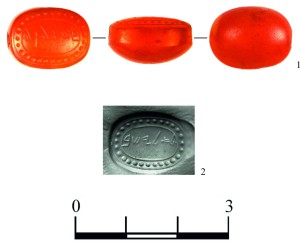 Archil S. Balakhvantsev*, Roman A. Mimokhod**, Pavel S. Uspenskiy**
Archil S. Balakhvantsev*, Roman A. Mimokhod**, Pavel S. Uspenskiy**
* Institute of Oriental Studies RAS, Moscow, Russia (balakhvantsev@gmail.com)
** Institute of Archaeology RAS, Moscow, Russia (mimokhod@gmail.com; uspensky07@mail.ru)
Keywords: Middle Sarmatian culture, scarab seal, Eliashib, son of Eshiyahu, Judah, Arad.
This paper is a publication of a gem-intaglio encountered in a Sarmatian burial of the first half of the 1st century AD of the Chebotarev V cemetery in the Rostov Oblast. The seal is an oval cornelian scarab. A single-line inscription l ʾlyšb ‘(property) of Eliasheb’ runs along its long axis. Iconography and ortography imply that the seal is Hebrew. Onomastics has recorded only three bearers of this name: an owner of a seal of unknown origin; a person probably mentioned in the letters from Lahish; and the governor of a small fortress of Arad in the late 7th–early 6th century BC. Judging from the palaeographic data, primarily the shape of the yōd and the aleph, the inscription can be dated to the 7th century BC. It is worth noting that its script is similar to that of the seals of Eliashib from Arad. Iconographic and palaeographic analysis of the Don find suggests that it initially belonged to Eliashib, son of Eshiahu, the governor of the fortress of Arad in Judah in the late 7th–early 6th century BC and was lost before its capture by the Edomites.







